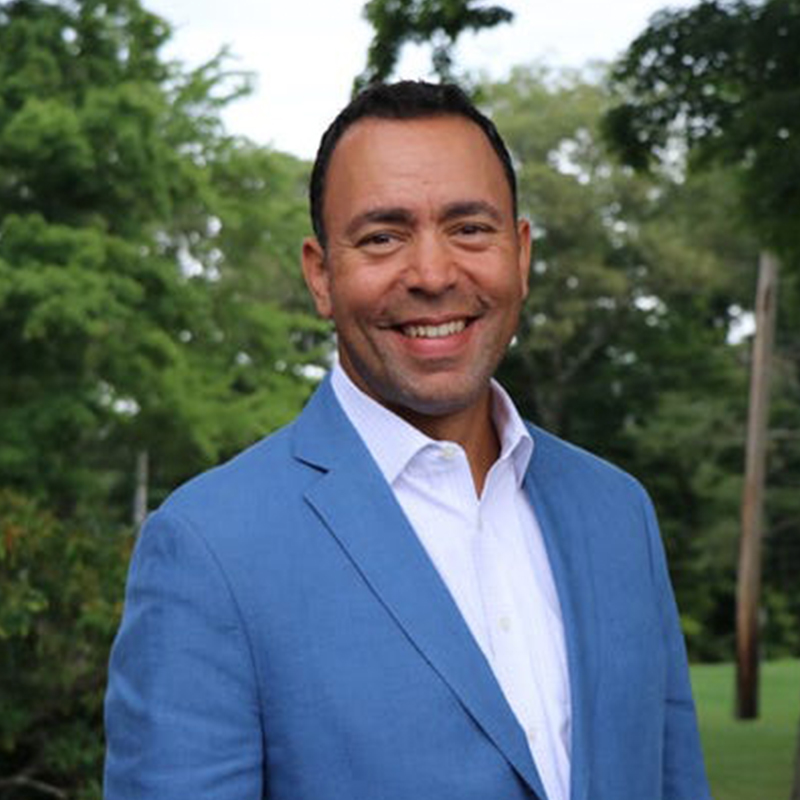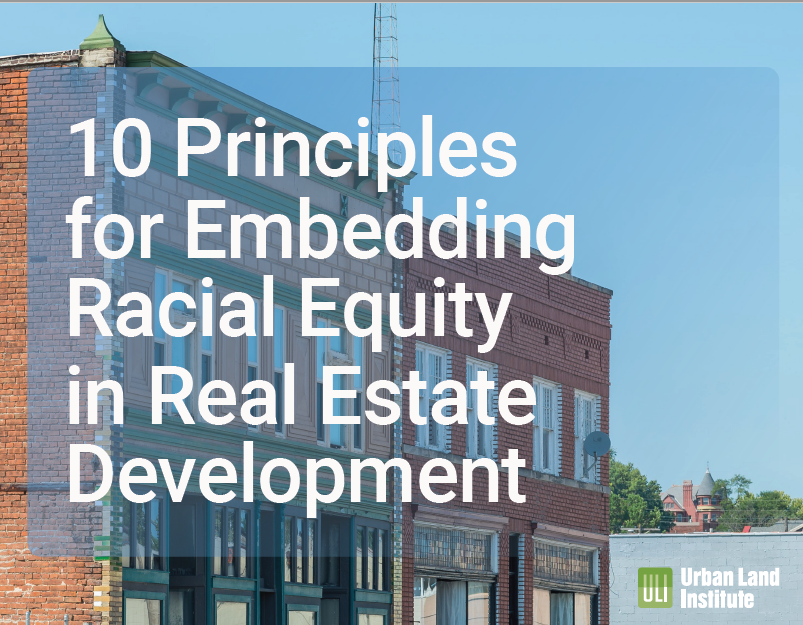Share:
ULI San Antonio ONLINE LUNCH & LEARN: Exploring 10 Principles for Embedding Racial Equity in Real Estate Development
Pricing
| Standard Pricing Until December 9 | Members | Non-Members |
|---|---|---|
| All Types | FREE | FREE |
Increasingly, the industry is recognizing that an elevated focus on racial equity can have benefits for financial and social returns. This lunch and learn will host a discussion on how to use the 10 Principles for Embedding Racial Equity in Real Estate Development to predicate such benefits, focusing on how to merge racial equity and financial equity to a local business case. Taidgh McClory, a Social Impact Enterprise Expert based in Boston, will be our featured guest.
Registration is free.
Agenda
12:00pm Introductions, San Antonio Context, 10 Principles Summary
12:10pm Taidgh McClory, merging social equity and financial equity
12:30pm Q&A Taidgh McClory
12:40pm Open Discussion, how can this be applied in San Antonio?
BIOS
 Taidgh H. McClory
Taidgh H. McClory
Founder, T.H. McClory, LLC
Taidgh H. McClory is the Founder & Managing Principal of T.H. McClory, LLC, a leading social impact enterprise dedicated to devising and implementing equity, inclusion & diversity strategies for the commercial real estate industry in New England and across the US. McClory’s career in commercial real estate and advertising has spanned over 24 years and includes expertise in strategic planning, real estate brokerage, marketing, brand planning, market research, and economic development. He most recently served as Director of Social Impact & Inclusion for MP Boston and before that Managing Director/Partner at CBRE/New England, where he led sales management, business development and civic engagement across the NE region.
A civic leader and champion of diversity, equity & inclusion in the commercial real estate industry, McClory is an active member of Real Estate Executive Council (REEC), the Urban Land Institute: Responsible Investment Property Council, as well as a handful of initiatives focused on economic development, social impact, diversity/equity/inclusion, commercial real estate, education, and philanthropy. Most recently McClory was the recipient of the 2020 – National Commercial Real Estate Development Association’s President’s Award by the NAIOP-MA Chapter.
McClory graduated from Dartmouth College with a BA in History & Studio Art and currently serves on the Board of Trustees for St. John’s Preparatory School, the Board of Directors for Massachusetts Economic Alliance (MassEcon); the Executive Council for The Partnership, Inc., and Board of Directors for Beyond Walls.
 Pegy Brimhall
Pegy Brimhall
Principal, Figurd
Pegy Brimhall is the Founder and Principal of Figurd Development, a design-driven urban infill development firm in San Antonio. Figurd is currently developing two new communities with a total project value of $70m. At Figurd, Pegy shapes the concept, investment structure, team, design, and market strategy for each project. With almost 20 years of real estate and AEC experience, she has previously managed multifamily, commercial and residential projects with budgets ranging from $1m to $2b throughout the United States, Europe, and Asia.
Pegy holds a First Professional Bachelor of Architecture degree from The University of Texas at Austin School of Architecture and a Master of Business Administration degree from the Johnson School of Business at Cornell University. She enjoys time with her family and advocates for women's leadership, economic empowerment of marginalized groups, and animal welfare.
 ULI's 10 Principles for Embedding Racial Equity in Real Estate Development Report
ULI's 10 Principles for Embedding Racial Equity in Real Estate Development Report
Purpose: This report summarizes ten guiding ideas on embedding racial equity in real estate development based on a ULI workshop and member engagement process, serves as a call to action for the real estate industry to make racial equity central to development, and provides best practices to help translate motivation to work on racial equity into action.
Audience: The primary audience includes real estate professionals interested in using different levers for change—at the personal, company, and industry scales—to make racial equity a central part of development, including in their professional practice, the industry, and community outcomes.
Background: The 10 principles emerged from a November 2021 workshop that convened ULI members and other real estate professionals who are experts on racial equity.
According to Racial Equity Tools, racial equity is “the condition that would be achieved if one's racial identity no longer predicted, in a statistical sense, how one fares. When we use the term, we are thinking about racial equity as one part of racial justice, and thus we also include work to address root causes of inequities, not just their manifestation.”
The ten principles reflect this understanding of racial equity and the role that the real estate industry has played in creating and perpetuating injustices, the workshop participants’ expertise and experiences, and ULI’s mission to shape the future of the built environment for transformative impact in communities worldwide.
Principles
Principle One: Embed racial equity across all aspects of your real estate development practice. Although many people have been prioritizing racial equity for years, societal expectations about racial equity are becoming more widespread, with significant implications for the real estate landscape. Real estate professionals must start making racial equity central to their professional practice so that they are prepared to operate and thrive in a new environment. This requires changing standard real estate development practices and policies in ways that center racial equity at all stages. Achieving just and fair inclusion requires real estate practitioners to apply a racial equity lens to all aspects of their work: their own organizations; the communities in which they operate; their consultants, vendors, and contractors; and their customers, investors, and capital partners.
Principle Two: Commit to building your knowledge and optimizing your personal and institutional power. Although racial equity requires systemic and structural change, real estate professionals can also advance racial equity using their personal and institutional power. Personal change requires deep internal work, and personal change leads to professional change. After all, development is not just about projects—it is primarily about people. Everyone can be a leader on racial equity. Do not underestimate your power to model values and create transformational change; everyone can challenge policies and practices within their sphere of influence as an advocate, ally, or leader.
Principle Three: Articulate the racial equity business case. Embedding racial equity into real estate development can reduce risk and increase value. When setting a business strategy, real estate professionals must begin by better understanding risk (e.g., the risk of not prioritizing racial equity), gaining a more complete understanding of return on investment (ROI) that recognizes the value of equitable development, and tailoring the racial equity business case to individual projects. Because racial equity has not been a mainstream part of real estate education or development practice, real estate professionals often believe that they need to make the case for racial equity or that it will add costs; however, investing in equitable development has repeatedly demonstrated its ability to increase returns and reduce risks.
Principle Four: Use data to ensure equitable processes and outcomes. Real estate professionals can use community-informed data and measurement in service of enhancing racial equity and accountability before, during, and after development. It is important to set measurable goals for outcomes (rather than outputs) and report progress in a transparent manner. These metrics can help real estate professionals understand the benefits of racial equity and enhance the adoption of equity-promoting practices. Data can demonstrate progress to community stakeholders and hold developers accountable to others and themselves. Internally, data and communication are just as important in creating and building on diversity, equity, and inclusion (DEI) strategies.
Principle Five: Leverage capital to drive equitable change. Using capital to drive equitable change includes expanding access to capital, expanding the type of capital that developers bring in, and developing more complete understandings of risk and return. This requires education to help people overcome biased ideas about risk, sponsorship, and credibility. Capital is key for not only funding equitable development but also ensuring that the investment benefits accrue to existing residents and communities marginalized by racist policies and practices.
Principle Six: Understand and address current and historical context. Understanding both historical and current structures—including policies, programs, and practices with a racist impact—shaping the project, community, and team provides the context necessary to mobilize the development team’s ability to promote racial equity and to inform how the industry moves forward. The context includes not only the history of the local area but also the history of the country, with people of color experiencing the impacts to this day. This requires both personal education and engaging and learning from the local community.
Principle Seven: Recognize the power of language. Language matters, and by using terms in a thoughtful, inclusive, and actionable way, real estate professionals can more accurately talk about and more effectively work toward a vision of racial equity. This report does not develop a shared language or framework for racial equity, but it does highlight the need for a common understanding of racial equity, particularly as it applies to real estate. Although creating such a shared language and framework will likely take an industry-wide effort, individual practitioners can seek to accomplish this on a smaller scale, including within their companies and their projects.
Principle Eight: Create a community-centered development process. Communities need the opportunity to meaningfully inform the projects that will affect them. This begins with ensuring that a broader group of stakeholders is part of the process and has the ability to provide input. This way, not only is the community shaped by the project but also the project is shaped by the community so that it responds to local needs and provides value to community members, including racialized groups.
Principle Nine: Build trust, transparency, and credibility. Embedding racial equity in real estate development requires trust, transparency, and credibility as the foundation of all relationships. When relationships—whether with communities, within companies, with vendors and business partners, or across sectors—are built with integrity and empathy, trust can be developed and maintained on both sides. Given the history of real estate and its current lack of diversity, the industry is not starting from a neutral place and must actively make efforts to overcome past harms.
Principle Ten: Form strong, intersectoral partnerships. Partnerships are a powerful way to make the focus on racial equity in development projects more feasible (e.g., expand a firm’s capacity for deep community engagement), to support local developers, and to maximize the impact of community benefits. By seeking partnerships, including with people and organizations embedded in the community (making sure to amplify historically excluded voices), project teams can approach challenges with an expanded set of tools and a more holistic understanding of success and local needs.
Key Takeaways
These key takeaways came up throughout the workshop, are infused throughout the principles, and are reflected throughout this report. Although these takeaways are not principles themselves, they are integral to understanding the thinking behind each principle and can help inform work on racial equity in real estate development.
- There is an imperative for racial equity in real estate. The real estate industry has historically had a significant role in creating and perpetuating racial injustices that continue to this day. Now, real estate has a responsibility and opportunity to reckon with that history and remedy its legacy of health, economic, and other disparities in communities today. As an organization created by and representing the real estate industry, ULI has often played an explicit or implicit role in perpetuating inequities.
- The industry needs a comprehensive approach to change. Change not only looks like more equitable community outcomes but also looks like a focus on racial equity within the real estate industry, such as new business practices, power sharing, and diversity and inclusion initiatives. This approach influences development decisions, which then shape community outcomes. It is currently possible to adopt the best practices described within each principle, and it is often profitable to do so.
- Understanding historical and present context is key. To work effectively on racial equity, it is critical to first understand the historical role that real estate practices played in creating and perpetuating racial injustice, with many people of color still experiencing the impacts today. These impacts include reduced access to opportunities for building wealth and to real assets—the places where people live, learn, and work. Many existing practices continue to perpetuate these impacts as well.
- Everyone can take action. Action is necessary, and it must be intentional and include accountability mechanisms. Although industry leaders have the greatest responsibility to motivate change, everybody can play a role, whether in their development decisions or in their personal relationships. Instilling dignity and respect in all approaches to development is fundamental to working on racial equity. Personal behavior and interpersonal relationships are just as important as outcomes.
- This work is both personal and professional. Doing the internal work to understand and act on racial equity issues is necessary to imbue these ideas throughout real estate professionals’ development practice. Development directly deals with people and issues of identity and justice, not just projects.
- Mind-sets matter. Real estate development has the potential to move from being an extractive process to a restorative one. This requires innovation not only in real estate practices but also in mind-sets: how people define value and risk, how project teams view communities as equal partners, and how the industry views its fundamental purpose.
- This work has real impacts. Because real estate meaningfully and directly shapes how people live, embedding racial equity into development has the potential to measurably improve people’s lives. It is the first line of access to fundamental resources, social connections, and services in communities. Real estate is the primary force for wealth creation in the United States, and everyone should have the opportunity to share in it regardless of race.
- More is needed. The 10 principles are just a starting point, and they are meaningless if they do not lead to action. Some real estate professionals are already doing this work, and their expertise and experiences have informed this report. Practitioners can use these principles to guide their urgent and necessary work on racial equity.
